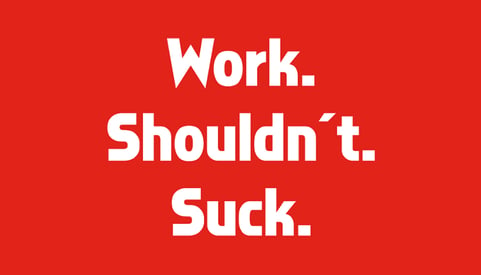7 Tips on Crafting Virtual Workplaces from Work Shouldn’t Suck
Big Ideas | How We Work | Remote Working | People Operations | COVID-19
Work. Shouldn’t. Suck. promotes people-centric organizational design for thriving workplaces. And these days, workplaces are increasingly going fully virtual, often in the span of days or weeks. How do we make sure that the transition sucks as little as possible?
Founded and operated by members of the Fractured Atlas People team, Work. Shouldn’t. Suck. provides resources and works with companies and organizations using people-centric organizational design tools for creating diverse, inclusive, and equitable workplaces.
On their most recent podcast episode, host and Fractured Atlas Chief Operating Officer Tim Cynova chats with Chief Technology Officer Shawn Anderson, Associate Director of People Operations Nicola Carpenter, Senior DevOps Engineer Andrew Hanson, and Chief External Relations Officer Lauren Ruffin.
They talk through building a successful virtual workplace, managing boundaries and setting expectations, security concerns, and how the COVID-19 pandemic forces organizations to have conversations about workplace culture that many probably should have already been having about accessibility, virtual communication, and more.
Take a listen to the full episode below. Or, if you don’t have time to listen to the full episode right now, check out some of the high-level takeaways we’re still thinking about.

1. Iterate to Ensure a Successful Virtual Workplace
For Tim Cynova, turning into a virtual workplace isn’t a one and done shift. It has to be constantly iterated on. Don’t use failures and challenges as opportunities to say that virtual working isn’t for your organization; use them to see what wasn’t working and why. What resources didn’t the team have? What different resources or support might they need?
He encourages teams to ask themselves,
“Why might that thing have failed? Was it the right person? Were they able to work from home? Did they have the right tools? Or did it fail because they had to call in on a physical phone and they were the only person of 20 people who wasn't in that meeting and their voice couldn't be heard, literally or figuratively in that meeting?”
2. Trust Your Virtual Team
One of the biggest challenges that virtual teams face is trust. Managers might wonder how they can know that their team is working if they can’t see them in the office. And employees can feel pressure to “prove” that they are online and working. Transitioning to a virtual team requires a new kind of trust.
But, Andrew Hanson points out that the trust required to have a successful virtual team is the kind of trust that managers should have had in their team all along.
He asks, “Would you rather have the person underneath you, your work or whatever, working incredibly hard, as hard as they can, putting out a ton of work for five hours a day or sitting in an office for eight hours and four of those hours they're on their phone looking at Facebook...
"If you don't have trust in [your team], you don't have trust in them. Quite frankly from my perspective, being a manager, that's a management problem. That's not a worker problem."
Nicola Carpenter brings up specific tools that the Fractured Atlas team uses to measure productivity and success in a virtual team, objectives and key results. And reminds us that the traditional measurements of productivity might not be that effective after all. “There's got to be a way, besides seeing people sitting at a desk to assess if people are doing their work or not. Because sitting in a desk and looking at a computer screen doesn't necessarily mean that work is actually happening.”
3. Equalize the Experience of Virtual Working
For companies and organizations that are transitioning to virtual work piecemeal, defaulting to a “virtual first” approach equalizes participant experiences and makes the transition easier overall. Virtual first means that for every meeting, whether or not people can physically gather, they meet over video conferencing to avoid a conference room full of people and a few stragglers calling in. Virtual is the first choice and not the contingency.
As Lauren Ruffin says it well. “There's nothing dorkier than when you're on video and people are in the conference room. Somebody says something funny, everybody's laughing. You're like, ‘Oh, what happened? What are they saying?’ You just miss stuff.”
Because so many people are going virtual at the same time, Shawn Anderson thinks “it's an opportunity to lean in and try to set up something that allows remote work to flourish across a larger swath of the organization.” Rather than trying to hold on to the forms of communication that you used when working in an office, pivot to a virtual first approach overall.
Everyone needs to embrace new tools and new workflows together. For Tim Cynova,
”It equalizes the experience and we figure it out together. We figure out what's necessary for us to do on Zoom, necessary for us to do in email. This one foot on one side, one foot in the other, creates this place where it never works out great for the people who are not in the physical room because of those things.”
4. Find Creative Ways to Create Boundaries Between Remote Work and Not-Work
While some employers and managers worry that if their team doesn’t come into an office, they won’t ever log on to their work computer, what we see is actually something different. Tim Cynova notes, “When people work from home, they tend to work longer hours than they would if they went into the office because they don't have an easier or clear delineation of start and stop.”
Nicola Carpenter shares a tip that her friend gave her - to develop a virtual commute, something to do at the beginning and end of the workday, to notate when you are in work-mode and when you aren’t. Because she lives in the New York City area, she doesn’t have space for a dedicated room or desk for working, so she has to get creative.
“I have been working on my kitchen table, but I sit on a different side of it than the side that I eat on and I specifically set up my laptop with my laptop stand, my keyboard, my mouse, my notebook, and I set it all up. I then start my workday. At the end of the workday, I put it all into a box and I do not see anything related to my work.”
This can get even trickier if you use your computer for leisure activities. For gamers, hackers, and software enthusiasts, how can you tell the difference between work and not if you’re still staring at the same laptop?
Andrew Hanson runs into this issue. “I often not so jokingly say my hobbies are in the same place where I work. So I sit here in front of this computer and I work, and then this is the same place where I also like to do other things. I like to program my own things and build my own things. So sometimes I have a very hard time separating that and it's very difficult because then I'm in the same space for 12 or 14 hours a day.”
From an organizational standpoint, you can encourage your team to think creatively about creating boundaries around their working hours. Tim Cynova shared an example from the Fractured Atlas Slack channel. Someone asked “Do you wear shoes and socks when you work from home.” He found the responses illuminating.
“Just one simple question posted there really opened up all these different ways of people approaching how they think about their home workspace in a similar way. So I think that's sort of fun, but also gets useful information for teams to connect, to see how everyone's doing and also learn different ways of approaching maybe how you want to think about your remote work.”
5. Check if Collaboration Tools Offer Discounts for Small Businesses or Nonprofits That Work Virtually
The entire panel understands that nonprofits and small organizations aren’t always able to pay for professional subscription levels to collaboration tools like Zoom and Slack. However, they probably need them. Tim Cynova brings up that oftentimes companies provide discounts on their subscription services for nonprofits.
Shawn Anderson adds that it's his first request for any vendor that he works with.
“Whether it's a communications platform or just any kind of software license, it's like a knee jerk. 'Hey, we're a nonprofit. What kind of nonprofit rates do you offer?' You'll find that sometimes you'll even get stuff for free."
So Slack, we get an organization level membership entirely for free, which is fantastic. Thank you Slack.”
Or, even if you can’t get a free version, sometimes it’s for the best. For example, free Zoom accounts only let you conduct 40 minute meetings. Tim Cynova suggests that this might be a good thing. “Maybe your meeting doesn't need to be longer than 40 or 45 minutes and Zoom tells you that.”
6. Improve All of Your Workflows to Work Remotely (or Not)
Tim Cynova shares a Twitter post that he recently saw. "I guess we're about to find out which meetings really could have been emails after all." And he thought, "Yeah, right. Yes. Finally."
Nicola Carpenter sees this moment as an opportunity to have the kinds of conversations about accessibility and work that we should have been having all along. She notes that workplaces have always had employees that are dealing with disabilities, chronic illness, mobility issues, and caregiving responsibilities. And that now those workplaces are finally having to have conversations that address working from home, flexible hours, and more.
“What magic. What magic we need. We always should have been thinking about what meetings do we need. We always should have been thinking about how we can have more flexible work environments.”
7. Don’t Stop at Virtual Workplaces - They are Just the Beginning
Lauren Ruffin notes that the changes we’re all going through as a result of COVID-19 are connected to bigger changes with how we work, what events look like, what it means to gather.
“It isn't just about a pandemic in the `Rona. It's really about how the world is shifting. Climate change is real. We're going to see more and more events, especially on coasts, that are going to be canceled.”
She encourages event organizers to start thinking about developing ethical practices for planning events: virtual opportunities for events, contingency plans, and consideration for extreme weather events that might make physical gathering impossible.
Tim Cynova suggests a thought experiment called a pre-mortem exercise where you make plans for when everything goes right, everyone loves it, and it’s wildly successful. And then you make plans for what happens if it ends in “ashes and tears.” He says, you “go one by one to, if that thing happens, we will put them in order, what's most likely to happen... But then you go one by one and say, if that thing happens, this is how we're going to respond. And then you essentially put it in your back pocket. If that thing does happen, you're much more prepared with what happens if an earthquake hits this area during our conference, a day before our conference, whatever it might be.”
At Fractured Atlas and at Work. Shouldn’t. Suck., we want to share information, strategies, and resources to help you get through this current moment. Listen to the full podcast here and check out how Tim Cynova suggests transitioning to a virtual workplace virtually overnight. Finally, if you want to talk through your own organization’s transition from in-person to virtual, reach out to Work Shouldn’t Suck.
About Nina Berman
Nina Berman is an arts industry worker and ceramicist based in New York City, currently working as Associate Director, Communications and Content at Fractured Atlas. She holds an MA in English from Loyola University Chicago. At Fractured Atlas, she shares tips and strategies for navigating the art world, interviews artists, and writes about creating a more equitable arts ecosystem. Before joining Fractured Atlas, she covered the book publishing industry for an audience of publishers at NetGalley. When she's not writing, she's making ceramics at Centerpoint Ceramics in Brooklyn.


